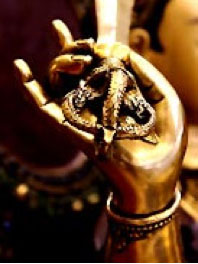Mudras, Hand Positions of the Buddha
In Buddhist sculpture and painting throughout Asia, the Buddha are generally depicted with a characteristic hand gesture, or mudra. Mudras are used primarily to indicate the nature and function of the deity.
Mudras are thus gestures which symbolize divine manifestation. They are also used by monks in their spiritual exercises of ritual meditation and concentration, and are believed to generate forces that invoke the deity.
They are a non-verbal mode of communication and self-expression, consisting of hand gestures and finger-postures. They retain the efficacy of the spoken word, and are used to evoke in the mind, ideas symbolizing divine powers .
Each of the fingers, starting with the thumb, is identified with one of the five elements, namely the sky, wind, fire, water, and the earth. Their contact with each other symbolizes the synthesis of these elements. Every form in this universe is said to be composed of a unique combination of these elements..
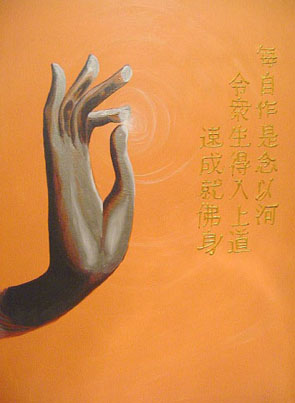
SOME BUDDHIST MUDRAS ARE :
Dharmachakra Mudra;
Teaching Preaching, Turning the Wheel of Dharma
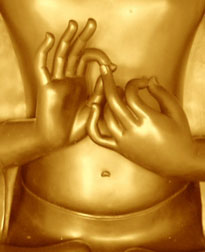
Dharmachakra in Sanskrit means the 'Wheel of Dharma'. This mudra symbolizes one of the most important moments in the life of Buddha, the occasion when he preached to his companions the first sermon after his Enlightenment in the Deer Park at Sarnath. It thus denotes the setting into motion of the Wheel of the teaching of the Dharma.
In this mudra the thumb and index finger of both hands touch at their tips to form a circle. This circle represents the Wheel of Dharma.
The three remaining fingers of the two hands remain extended. These fingers are themselves rich in symbolic significance:
The three extended fingers of the right hand represent the three vehicles of the Buddha's teachings, namely:
* The middle finger represents the 'hearers' of the teachings
* The ring finger represents the 'solitary realizers'
* The Little finger represents the Mahayana or 'Great Vehicle'.
The three extended fingers of the left hand symbolize the Three Jewels of Buddhism, namely, the Buddha, the Dharma, and the Sangha.
Significantly, in this mudra, the hands are held in front of the heart, symbolizing that these teachings are straight from the Buddha's heart.
=============================================================
Dhyana Mudra
Meditation, attainment of spiritual perfection
The Dhyana mudra is the mudra of meditation, of concentration on the Good law, and of the attainment of spiritual perfection. According to tradition, this mudra derives from the one assumed by the Buddha when meditating under the pipal tree before his Enlightenment. It indicates the perfect balance of thought, rest of the senses, and tranquility.
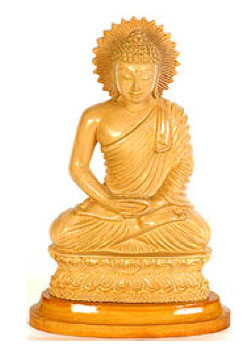
The Dhyana mudra may be made with one or both hands. When made with a single hand the left one is placed in the lap, while the right may be engaged elsewhere. The left hand making the Dhyana mudra in such cases symbolizes the female left-hand principle of wisdom. Ritual objects such as a text, or more commonly an alms bowl symbolizing renunciation, may be placed in the open palm of this left hand.
When made with both hands, the hands are generally held at the level of the stomach or on the thighs. The right hand is placed above the left, with the palms facing upwards, and the fingers extended. In some cases the thumbs of the two hands may touch at the tips, thus forming a mystic triangle. The esoteric sects obviously attribute to this triangle a multitude of meanings, the most important being the identification with the mystic fire that consumes all impurities. This triangle is also said to represent the Three Jewels of Buddhism, mentioned above, namely the Buddha himself, the Good Law and the Sangha.
==============================================================
Vitarka Mudra
The Gesture of Turning the Wheel of Dharma and Meditation
The gesture of the right hand stands for turning the wheel of Dharma, while that of the left hand symbolizes meditation. The two conjoined symbolize teaching the Dharma while in meditation on emptiness
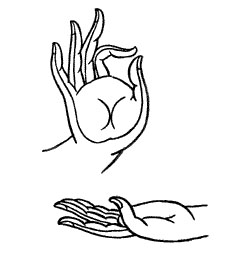
===============================================================
The Karana mudra
is the mudra which disposes of demons. It is also used to remove illness and negative thoughts. It is made by raising the index and the little finger, and folding the other fingers.
